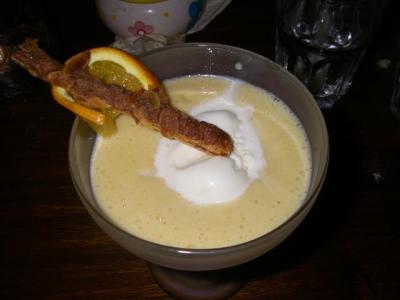Continued from yesterday”¦ After we finished at the museum, we headed to Rincon to go to the Mangazina di Rei cultural center. It is housed in the second oldest stone building on the island, built in 1824, which was originally built as a food and farm tool storage center. The center tries to actively preserve the cultures and traditions of 100 years ago. We expected it to be a museum where you wander around at your own pace, but it was actually a guided tour. We joined a tour group about halfway through the tour. The group had just gone out into the gardens.
In the gardens, they grow the plants that were used for every day living, from food to export crops to materials for tools. They pointed out a tamarind tree, then gave us some tamarind juice to taste. It tastes kind of like beans and sugar and is different. They pointed out a calabash tree. Calabash are inedible, hard, and round, and are good for making assorted tools and cookware, such as bowls, ladles, and so forth. The musical instrument maracas (the shakers popular in Latin American music) are made from calabash, too.
They showed us candle cactus, which are used to make the living cactus fences. For some reason, they can only be cut on a full moon in the dry season or they rot. The guide showed us the tools they used to cut, move, and replant the cactus along the fence. The cactus cuttings form new roots and become a living fence.
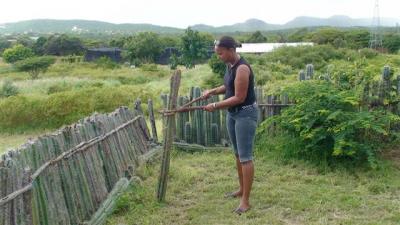
The guide also pointed out the kadushi cactus that they make a traditional soup from, and also explained how they cut and skin the cactus to get at the pulp inside. The cactus is absolutely enormous, but only young shoots are eaten.
They showed us the plants that sorghum flour is made from, which was the staple of the traditional diet. Sorghum is one of the oldest grains in the world and was brought over from Africa by the slaves. There are three varieties of the plant. They plant them with the least tasty of the group around the outside of the plot, the middle of the road variety right behind the outer variety, and the best tasting protected in the center of the ring. The birds tend to eat the outer plants more so than the inner ones, so by planting this way, they harvest more of the tastiest crop.
Within the garden are several houses. Each house represents a different construction style that was typical to the island. One house was built in the traditional Indian style, another in the traditional African style, another in the European style, and what evolved from there. All of them were very small, even the most expensive and elaborate of them. The biggest had three rooms and most were one room. None of them had a kitchen. The different style houses were all furnished and decorated according to the people group and the era. All of them had sparse furnishings. One place had a chamber pot right next to the head of the bed, which was funny.
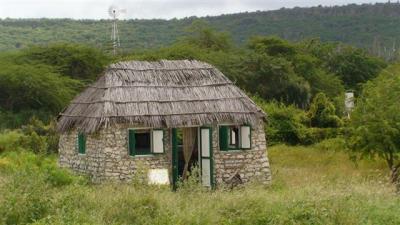
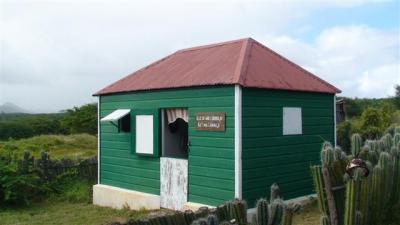
There was also a lean to, which in the old days were used as the kitchen. It is certainly different than today’s kitchen! The stove was three big stones of about the same size places in a triangle. They’d build a small fire in the center and put the pot on top. The cupboards were pots hung from the ceiling with special lids to keep the rats out. They actually ground sorghum flower right in the kitchen using flat rocks.
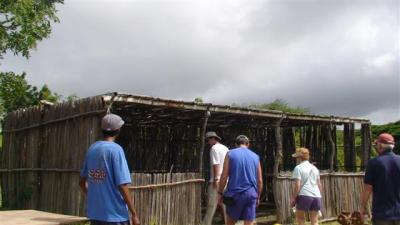
Also on display in the lean-to is an aloe trough. Aloe was one of the four items grown on the plantation for exportation. The slaves used to cut the aloe and put it in these toughs that angle down into a bucket. The liquid would slowly, slowly trickle into the bucket. The slaves would get frustrated at how slow the bucket filled, and would often help fill the bucket up faster by urinating into the bucket. The aloe would get dehydrated (baked into a brick) for export. Aloe is in the garden, too.
Another thing they exported was mesquite charcoal. There is a charcoal oven in the garden. The charcoal is basically made exactly the same way it is done on Crete, where they gather wood from the mesquite trees and let it smolder underground until it becomes charcoal. The guide pointed out a mesquite tree for us.
There were lots more interesting tidbits of information, but at that point our brains were getting full and now we can’t remember it all. But it was all interesting. It is fascinating how people learn to make the most of what they have. The plants all looked pretty useless to us at first glance since they are not plants that our culture uses, but the locals figured out how to utilize every one of them for a better quality of life. Beyond the garden is active farmland and a greenhouse where they grow other types of foods, but it wasn’t part of the tour.
The garden is the last stop on the tour, so when we finished there, everyone else left. The two of us followed the guide into the mangazina. It is a huge single room. All around the room are various stations with small displays. Examples of displays include kitchen utensils, table ware, farm tools, traditional clothes, costumes for holidays, religious items, etc. Something that surprised us is that the slaves were Catholic. We know the Spaniards had probably forced the Indians to convert to Catholicism, but we would have thought that the Dutch would have forced the slaves to all become protestant. But, the Dutch didn’t want to be the same religion as the slaves and made no effort to convert them. The Indians must have converted the Africans to Catholicism.
Our last stop was the patio area of the mangazina, where we were shown the local instruments. We participated in making music while they taught us local dance moves. It was fun. We really enjoyed that it was an interactive tour where the guide actually demonstrates things versus just wandering around a museum. We are impressed with the cultural center on the whole. Their primary focus is keeping their culture alive. The elders in the community teach the youngsters traditional life skills, such as farming, cooking and building. They tell the kids stories, both real and legend, to keep history and folklore alive. It is really a neat place.
After the tour was over, we headed back to Kralendijk and went grocery shopping. Even though we had a car, we couldn’t go too crazy on stocking up because we still have limited space in the dinghy for ferrying groceries. But, we managed to get fairly well re-supplied. While we were shopping, we saw what looked like apple Danish, so we bought some. We were most surprised to find it was filled with the spicy peanut sauce that is served on top of chicken satay. It was weird, and while we can’t say it was bad, it wasn’t good either.
At dinner time, we went to dinner at a tapas restaurant. Everything was awesome. We got several tapas. The first is pan fried goat cheese wrapped in bacon and covered with a thick, sweet honey-balsamic vinegar dressing and walnuts. Neither of us like bacon on its own all that much, but it seems like bacon tastes great when paired with just about anything. What else is so diverse that can you pair with melon, scallops, cheese, steak, mushrooms or lettuce?
Another dish we ordered was a salad of lettuce with apple, melon, orange and proscuttio with melon dressing. We also got fish thermadore, which is basically lobster thermador with white fish instead of lobster.
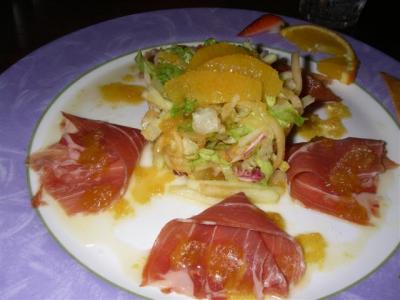
We got two desserts. One was called amaretto sabayon, which was basically a creamy, frothy amaretto soup. We also got bananas baked in phyllo dough and covered in caramel sauce. It was served fresh out of the oven, so it was hot and gooey.
